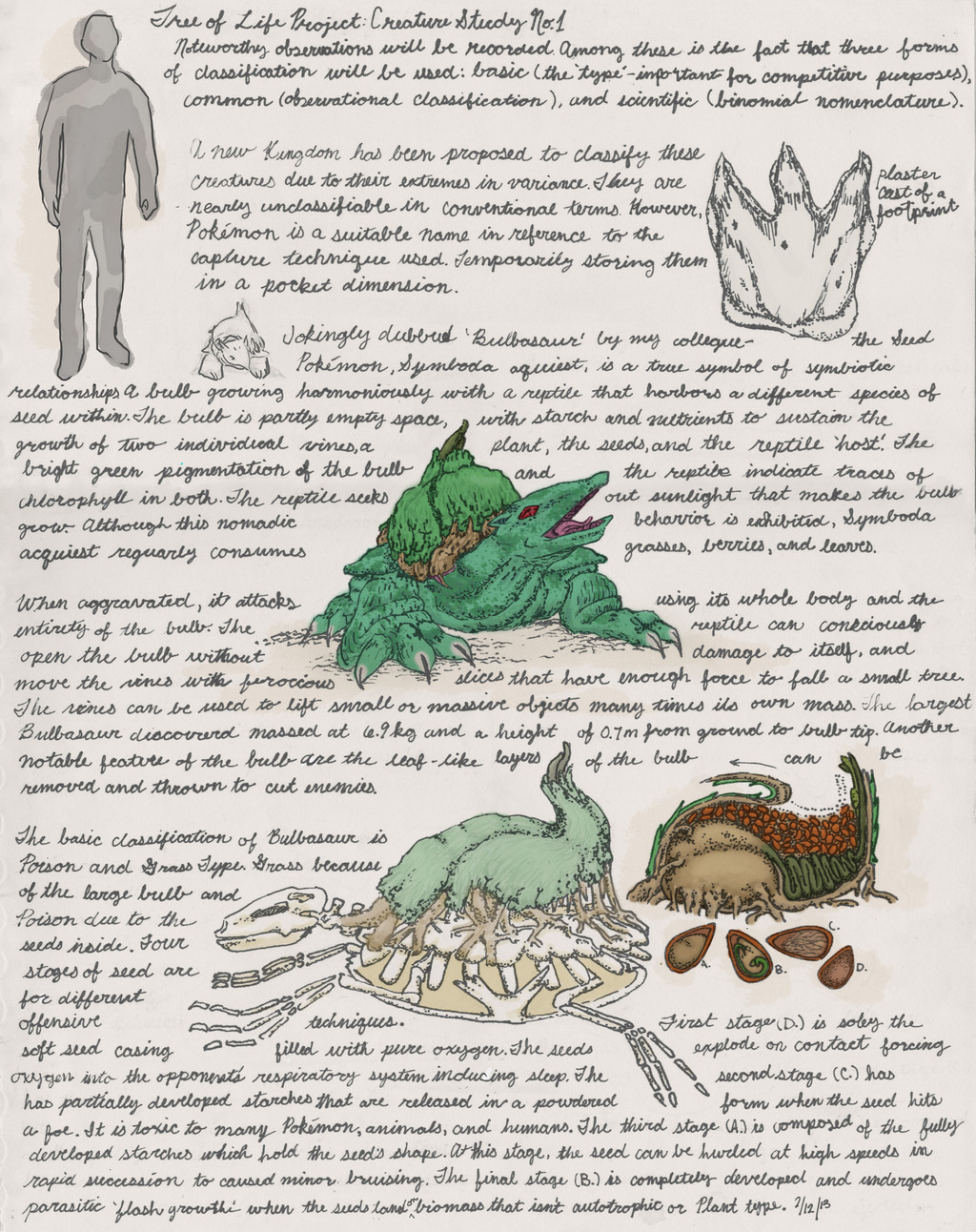HOME | DD
 Fishypaste — Bulbasaur Study
by-nc-nd
Fishypaste — Bulbasaur Study
by-nc-nd

#001 #creaturestudy #1 #treeoflifeproject
Published: 2013-06-11 20:17:51 +0000 UTC; Views: 2114; Favourites: 25; Downloads: 4
Redirect to original
Description
Why?1) I had too much time sitting in a car with nothing to do.
2) I wanted to do this for awhile.
3) I remembered soft-shelled turtles have a snout-like thing attached to their face.
4) Bulbasaurs are not frogs.
5) I am a big geek that likes to research.
6) I have major reality problems.
20+ hours (research, pencil sketch, written part, penning in, computer coloring)
[Bulbasaur]
[Ivysaur]
---
Guess what? I got the text all typed up nice and pretty! (It has all the typos my writing does.)
Tree of Life Project: Creature Study No. 1
Noteworthy observations will be recorded. Among these is the fact that three forms of classification will be used: Basic (the' type'- important for competitive purposes), Common (observational classification), and Scientific (binomial nomenclature).
A new Kingdom has been proposed to classify these creatures due to their extremes in variance. They are nearly unclassifiable in conventional terms. However, Pokemon is a suitable name in reference to the capture technique used. Temporarily storing them in a pocket dimension.
Jokingly dubbed 'Bulbasaur' by my colleague- the Seed Pokemon, Symboda aquiest, is a true symbol of symbiotic relationships. A bulb growing harmoniously with a reptile that harbors a different species of seed within. The bulb is partly empty space, with starch and nutrients to sustain the growth of two individual vines a plant, the seeds, and the reptile 'host.' The bright green pigmentation of the bulb and the reptile indicate traces of chlorophyll in both. The reptile seeks out sunlight that makes the bulb grow. Although this nomadic behavior is exhibited, Symboda aquiest regularly consumes grasses, berries, and leaves.
When aggravated, it attacks using its whole body and the entirety of the bulb. The reptile can consciously open the bulb without damage to itself, and move the vines with ferocious slices that have enough voce to fall a small tree. The vines can be used to lift small or massive objects many times its own mass. The largest Bulbasaur discovered massed at 6.9kg and a height of 0.7m from ground to bulb tip. Another notable feature of the bulb are the leaf-like layers of the bulb can be removed and thrown to cut enemies.
The Basic classification of Bulbasaur is Poison and Grass type. Grass because of the large bulb and Poison due to the seeds inside. Four stages of seed are for different offensive techniques. First stage (D.) is solely the soft seed casing filled with pure oxygen. The seeds explode on contact forcing oxygen into the opponent's respiratory system inducing sleep. The second stage (C.) had partially developed that are released in a powdered form when the seed hits a foe. It is toxic to many Pokemon, and animals, and humans. The third stage (A.) is composed of the fully developed starches which hold the seed's shape. At this stage, the seed can be hurled at high speeds in rapid succession to caused minor bruising. The final stage (B.) is completely developed and undergoes parasitic 'flash growth' when the seeds land biomass that isn't autotrophic or Plant Type.
Related content
Comments: 8

Perfection, just pure perfection. Your artist's comments made me laugh, and I relate so much XD
👍: 0 ⏩: 1

I can't believe you can actually read that!
Thanks, that means a lot from a fan like yourself. (Those region maps are pretty sweet!)
👍: 0 ⏩: 1

Of course! And gosh, thank you. Geekiness for the win, no?
👍: 0 ⏩: 0

Thanks! I'm going to try and keep doing this for the rest.
👍: 0 ⏩: 0





























